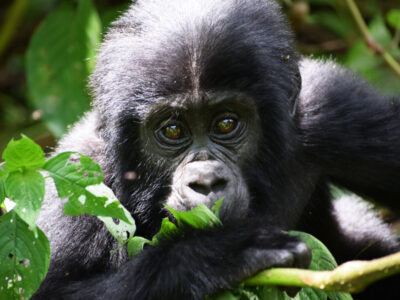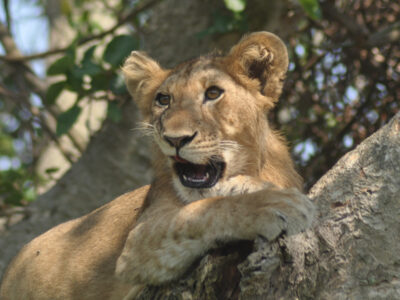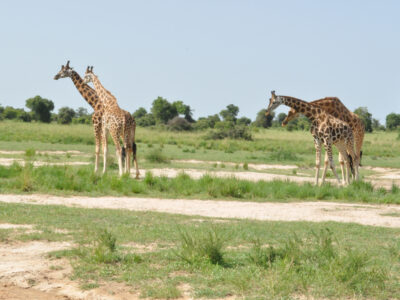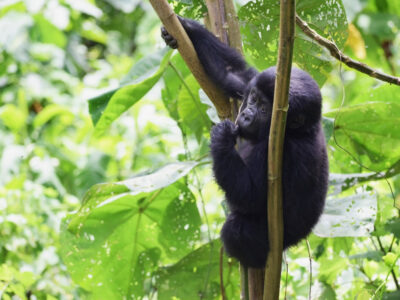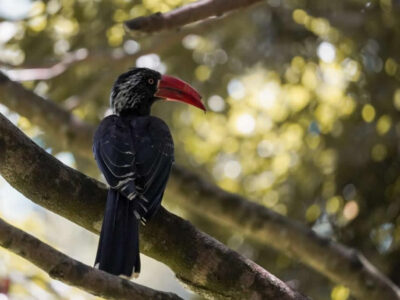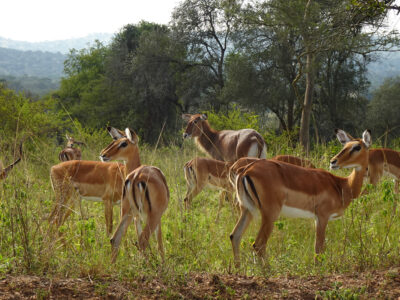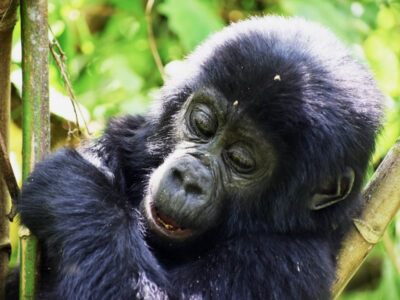Mgahinga national park is located in the southwestern corner of Uganda and it covers 3 northern slopes of Virunga volcanos that are; mount Muhavura (4127m), mount Mgahinga (3474m), and mount Sabinyo (3645m). It is said to be the smallest and luckiest national park of Uganda established in Kisoro district about 10km south and bordering volcano national park of Rwanda and west of D R Congo. Mgahinga national park covers an area of 33.7sq.km considered the smallest national park in Uganda first gazetted in the 1950s as a game reserve and later in 1991 ranging from 2,227m-4,127m above sea level.
Mgahinga national park spreads in three countries and each country is responsible for the security of its portion of the Virungas, the biggest part is covered in Uganda and that is the Kisoro district. The park (the Virungas) acts as a home to plenty of wild animals both endangered in the mountain. There are two national parks in Africa that protect the rare endangered golden monkeys such as the Mgahinga gorilla national park and the Volcanoes national park in Rwanda This gives a majestic natural beauty to visitors that enjoy the beautiful view of the park
Mgahinga national park stands out for its stunning scenery despite being a small park. Savannah woodlands, montane forests, marshes, bamboo forests, and Afro-montane forests, are all found in the park. The three dormant volcanoes, Mount Gahinga, Mount Sabyinyo, and Mount Muhavura, are the park’s most notable features. These mountains are a part of the vast Virunga mountain ranges, which also include the Bisoke, Karisimbi, and Nyiragongo peaks. As a result of the three mountains, a large portion of the park is located at an elevation of between 2,000 and 4,000 meters.
It comprises the ice age-producing terrain and the mountains that are more valuable to plants and animals because they can migrate up and down the mountain slopes in response to temperature changes. Nearly 480 gorillas dwell in Virunga, making it one of the luckiest places to find these endangered species.
There are 76 different kinds of mammals found in Mgahinga National Park, including mountain gorillas, golden monkeys, leopards, bush pigs, black-fronted duiker, buffaloes, elephants, black and white colobus monkeys, and forest hogs. More than 115 different bird species have been identified there, including endemics to Albertine and local forest birds like the Pin-tailed Whydah, Double-collared Sunbird, Yellow-vented Bulbul, Blue-headed Causal, Grey-capped Warbler, Black Kite, Rwenzori Turaco, Speckled Mousebird, Paradise Flycatcher, Rwenzori Nightjar, Firefinch, and White-naped Raven.
Top activities to do at Mgahinga national park
Gorilla trekking
About 100 kinds of endangered mountain gorillas live in Mgahinga National Park, though they frequently migrate to the borders with Rwanda and the Democratic Republic of the Congo. It only has one habituated gorilla family, the Nyakagezi gorilla family, which is accessible to trekkers. It is one of the largest habituated gorilla groups, with 5 silverback adults, including 2 females and 3 gorilla newborns. There were over 80 habituated gorillas in this park, but just one gorilla family remained there for a variety of reasons.

The most popular activity in Mgahinga National Park is gorilla trekking, which begins at 8:00 am every morning with training on how to behave around gorillas in the wild. Depending on where you discover them, the walk lasts between two and six hours, and you are only permitted to observe their activities for an hour from a distance of roughly seven meters.
It is advisable to go gorilla tracking when you are healthy because it requires frantic movement in deep forests that are rigged and dense with thorns. Good tracking outfits are also advised because gorillas share nearly 98 percent of human DNA, making it very easy for them to contract human diseases like the flu. You can come across other creatures that live in the park while hiking the gorillas, including the critically endangered golden monkeys, hyenas, black and white colobus monkeys, elephants, leopards, and duikers.
NOTE: The cost of a gorilla trekking permit in Mgahinga National Park is 700 dollars, and you may get one from the Uganda Wildlife Authority or one of their tour companies. Before their trip starts, visitors must make a reservation. All year long, the months of June and August are ideal for gorilla trekking.
Golden monkey trekking and habituation:
Similar to mountain gorillas, golden monkeys in Mgahinga National Park can trek within groups. They live at the tops of the park’s bamboo trees, which are typically fun, distinctive, active, little, nosy, and very quick. The Virunga Mountains in the Democratic Republic of the Congo, Rwanda’s volcanoes, and the Albertine region of Uganda are all home to the golden monkey.
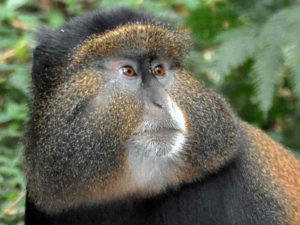
In Uganda, there are six habituated groups, each of which has more than 60 members. The habituation process for golden monkeys is similar to that for mountain gorillas; it begins in the morning and lasts between one and three hours in the forest, with an hour spent with the animals. Carry a camera and binoculars to record the unforgettable journey as you may see some birds while trekking. The habituation cost to have fun with them in the woodlands is about $100. They are fiercely protective of their lives from predators like the African Eagle, but when it’s rainy, they tend to hide because they can’t hear the eagles’ cries when they’re nearby.
Mountain hiking
In Mgahinga National Park, climbing one of the three main mountains is the best feeling. These volcanoes, which range in height from 4127m to 3474m respectively and comprise Muhavura, Sabinyo, and Mgahinga, may all be walked in three days. These volcanoes are a part of the Virunga Mountains, which span three nations: Uganda, Rwanda, and the Democratic Republic of the Congo. The oldest volcano in the park, Mount Sabinyo, also known as “the old man’s teeth,” is firmly situated in three bordering nations. Mount Muhavura, also known as a “guide,” is the highest of the three. It may direct you to other volcanoes in the park. On the other hand, Mount Mgahinga, known as “a pile of stones,” is the easiest to trek and takes 6 hours to accomplish.

A fantastic opportunity to see many aspects, including the vegetation found in the crater lakes, Lake Mutanda, and Edward marshes, as well as the dense forest of the Bwindi and Rwenzori mountain ranges, is to hike the three volcanoes. For hikers who wish to experience the breathtaking qualities of these summits and for novice hikers who want to trek for a day, they offer camping areas. It is always advisable to be prepared, bring food and water, and bring tents in case you have trouble returning to the slopes.
Birding: In the Mgahinga National Park, one can go birding in the swamps, lakes, woods, and volcanoes. In this park, you can see over 150 different bird species, including endemics to the Albertine Rift. The majority of the birds, including the black-headed waxbill, bronze sunbird, olive pigeon, Rwenzori Turaco, brown woodland warbler, cape robin, handsome francolin, tinker birds, cape robin chat, yellow-vented bulbul, white-necked raven, striped breasted tit, yellow-throated long-claw, white starred robin, cinnamon bracken warbler, streak The months of April and November are when some of these birds often migrate out of Europe.
Nature walks: Mgahinga National Park’s virgin forests, lakes, rivers, wetlands, and mountain slopes make for excellent locations for nature treks. The route on Mt. Sabyinyo’s slopes ends at the intersection of the borders of Uganda, Rwanda, and the Democratic Republic of the Congo. The walk, which is around five hours long and passes through several flora types, offers the opportunity to see primates like golden monkeys as well as spectacular views of the park, Bwindi impenetrable forest, and the larger Virunga mountain ranges from the caldera on the Gisozi hill. Some of the paths are challenging and demand good fitness levels to finish, such as the 5-hour Sabyinyo gorge hike.
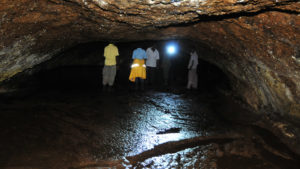
The Garama cave is located 3 kilometers from the park’s administrative center in Ntebeko and can be visited when taking a nature walk in Mgahinga. It is a stunning site that is 342 meters long and 14 meters deep. It contains the historical and cultural value of the Batwa people, who once lived in the park’s surroundings before being exiled so they could gaze over it and use the cave as a hiding place from other tribes. While on any of the routes for nature walks, stay awake and pay attention to the local birds’ charming songs and the loud calls of the monkeys as they swing from tree to tree. You might even come across elusive big creatures like elephants and antelopes.
The Cultural Tour:
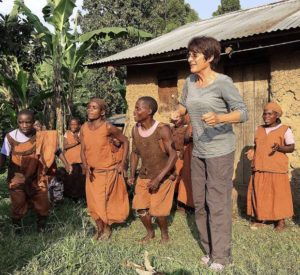 The Batwa tribe is the most intriguing tribe to reside in the areas of Mgahinga National Park. This is so because of how closely connected their past is to the park. Before being driven out of the Mgahinga forest in 1991 and relocated to its periphery, the Batwa spent years living there as hunters and food gatherers. They hunted, gathered fruits, collected herbs from the forest floor, and harvested honey as part of their daily routine. Even so, some of them continue to reside close to the park where they work as porters for tourists who go on gorilla treks. They are also entitled to a tiny share of the money the park makes.
The Batwa tribe is the most intriguing tribe to reside in the areas of Mgahinga National Park. This is so because of how closely connected their past is to the park. Before being driven out of the Mgahinga forest in 1991 and relocated to its periphery, the Batwa spent years living there as hunters and food gatherers. They hunted, gathered fruits, collected herbs from the forest floor, and harvested honey as part of their daily routine. Even so, some of them continue to reside close to the park where they work as porters for tourists who go on gorilla treks. They are also entitled to a tiny share of the money the park makes.
You will go to their farms to enjoy songs and dances performed there. While a portion of the funds raised goes to the Batwa entertainers and guides, the remainder goes to the community fund, which supports the purchase of necessities like books and child care costs and also establishes side projects and medical equipment.
Accommodation in Mgahinga National Park
Due to its proximity to Lake Bunyonyi and Bwindi Forest National Park, Mgahinga National Park offers a variety of lodging alternatives. There are lodges in the town of Kabale, in Kisoro, and close to the park. Numerous hotels are positioned well so that guests can utilize them as bases while participating in activities in both national parks. These lodges provide services that are affordable, mid-range, and opulent for tourists. These lodges are constructed as simple campgrounds, bandas, or conventional cottages. It is advisable to make hotel reservations close to park offices because several park activities, like gorilla tracking, begin quite early in the morning. The following are a few of the lodges in Mgahinga Gorilla National Park.
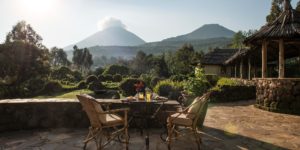
Mount Gahinga lodge: The lodge is situated in a natural environment with views of the Virunga Mountains and is close to the park’s entrance. To combat the cold climate brought on by the volcanoes, the hotel offers luxurious bandas that are completely self-contained and equipped with fireplaces. Twin/double or single accommodations are available at the lodge. Customers are offered scrumptious cuisine in the morning, midday, and evening, both internationally and locally.
Mutanda Lake Resort: On the shores of Lake Mutanda, between Nkuringo and Kisoro, is also the Mutanda Lake Resort, previously Nkuringo Safari Lodge. This location guarantees that locals will enjoy breathtaking views of the volcanoes and the picturesque lake. For individuals who want high-quality services but are on a tight budget, this resort is ideal. The tented self-contained rooms at Mutanda Lake Resort offer a round-the-clock room and laundry services. Each room has a verandah and is clean and roomy. The Resort arranges birding cruises on Lake Mutanda, nature hikes, and excursions to the Bwindi and gorilla highlands. Those who traveled to either Mgahinga or Bwindi for gorilla trekking are welcome at the resort.
Lake Mutanda Campsite: For individuals who enjoy the outdoors and want to explore the African wilderness in its natural environment, this campsite is ideal. This campground provides inexpensive lodging in a beautiful setting, with stunning views of Lake Mutanda and the park’s volcanoes.
Chameleon Hill Lodge: This magnificent lodge was constructed with a view of the stunning Lake Mutanda. The lodge is located in a lovely area with stunning views of the park’s three volcanoes. It is a good lodge for visitors who are interested in kayaking on Lake Mutanda, golden monkey tracking, bird viewing, visiting the Batwa, or gorilla trekking.
Mount Gahinga Rest Camp: This resort has lovely views of Lake Mutanda and the park’s highlands because it was built at the base of the volcanoes. There are three tents with private balconies in addition to the nine grass-thatched cabins. Visitors may also set up their own tents in specific areas in addition to the bandas. Solar power is provided via solar panels. The hotel organizes a number of events, including a trip to the Batwa tribe, and is located close to the line between Uganda, Rwanda, and the Democratic Republic of the Congo.
Other accommodation that can be accessed near Mgahinga national park includes clouds mountain gorilla lodge, traveler’s nest hotel, Virunga hotel, Amajambere Iwacu Community camp, and many others.
How to access the park
It just takes 8 to 10 hours to travel 482 kilometers from Kampala to Kabale and Kisoro town on an excellent road in order to reach Mgahinga National Park. The Ntebeko gate is the only entry to the park, and it’s always open from 7:00 am to 6:00 pm every day of the year. The park is located around 55 kilometers west of Kabale town and 15 kilometers south of Kisoro town.
However, regular aircraft from Kajjansi Airstrip or Entebbe Airport can also be used to reach the park. These flights take around an hour to arrive at Kisoro Airstrip.
When to visit Mgahinga national park
It is advised to keep in mind that the weather in Mgahinga National Park is erratic and cannot always be pleasant because of the high probability that you may anticipate it to be a dry season yet the region can quickly receive rain, leaving visitors disappointed. Therefore, you should always be ready for the unpredictable, before embarking on a gorilla trekking adventure, it’s crucial to wear a rainproof jacket, rainproof hiking boots, long pants, and long-sleeved shirts.
In the dry season, also known as the high season, which is from June to August and December to January, when the pathways are simple to hike and descend from the dense forest, gorilla trekking is at its best in Mgahinga National Park. Tourists must reserve their gorilla trekking permits in advance since during the peak season, from June to September, they become demanding and difficult to obtain on short notice.
The location receives less rainfall during the dry season, which is ideal for both excellent photography and the ideal gorilla trekking experience. Mountain gorillas do prefer to go deeper into the thick forest during the dry season, which makes trekking difficult. Travelers interested in gorilla trekking and hiking can check out our 4 days of trekking and hiking of mount sabinyo and those who want only to hike the 3 mountains can go for 6 days of hiking the Virunga ranges found in Mgahinga National Park for a wonderful experience.
Wet season (Low Season)
Heavy rainfall occurs in March, April, May, October, and November; as a result, the park roads and forest trails become slick and treacherous, making it impossible for visitors to access the park. However, the wet season has its benefits and is also a rewarding period for bird watching because it is during this time that migratory bird species can be easily observed. On the other hand, gorillas tend to move or stay close to the forest margins because there is an abundance of flora and other food for gorillas to eat, and the heavy rainfall helps to support the dry and withered grass in the dry season to grow to increase the food products





 The Batwa tribe is the most intriguing tribe to reside in the areas of Mgahinga National Park. This is so because of how closely connected their past is to the park. Before being driven out of the Mgahinga forest in 1991 and relocated to its periphery, the Batwa spent years living there as hunters and food gatherers. They hunted, gathered fruits, collected herbs from the forest floor, and harvested honey as part of their daily routine. Even so, some of them continue to reside close to the park where they work as porters for tourists who go on gorilla treks. They are also entitled to a tiny share of the money the park makes.
The Batwa tribe is the most intriguing tribe to reside in the areas of Mgahinga National Park. This is so because of how closely connected their past is to the park. Before being driven out of the Mgahinga forest in 1991 and relocated to its periphery, the Batwa spent years living there as hunters and food gatherers. They hunted, gathered fruits, collected herbs from the forest floor, and harvested honey as part of their daily routine. Even so, some of them continue to reside close to the park where they work as porters for tourists who go on gorilla treks. They are also entitled to a tiny share of the money the park makes.
